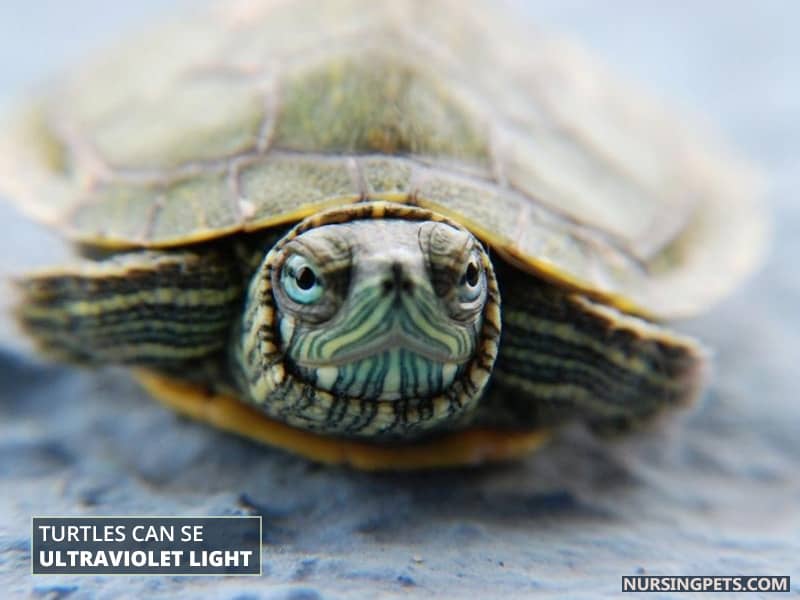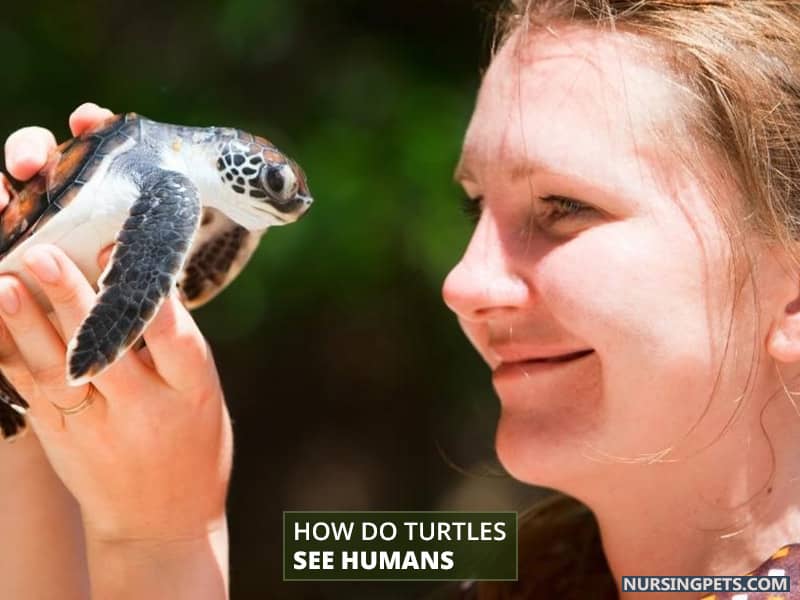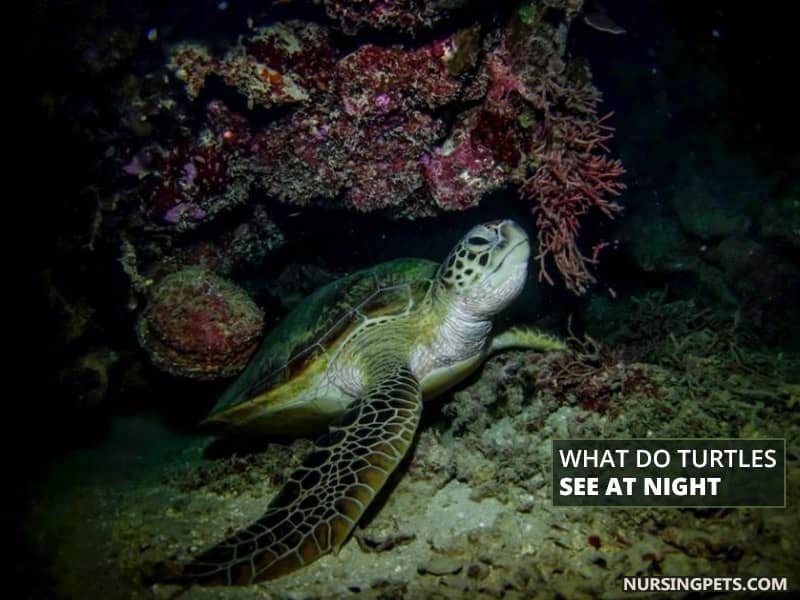How Do Turtles See The World?
Turtle vision might not be what you expect. While they have eyes on the sides of their heads, their sight isn’t as panoramic as you might think. Although we don’t know for sure, scientists explain what their vision could look like. So, how do turtles see the world?
According to the cheloniologists – turtles’ vision is more like our own with a few differences. They have a wide field of view and decreased ability to see things clearly at the edges. That is due to their eyes are set on the side of their heads, giving them mixed monocular and binocular vision. However, turtles can see both ultraviolet and infrared light, allowing them to see things we can’t. Also, turtles (the majority) can see colors but lack details.
There is a lot more to Turtle’s vision. We discuss this matter in detail with a few more related topics. So, if you want to know more about Turtle’s eyesight, this may be the right blog for you.
Related articles about turtles:
What does Turtle’s vision look like? (Facts About Turtles Eyes or Vision):
As children, many of us were first introduced to turtles through stories and movies like Finding Nemo and Teenage Mutant Ninja Turtles. Despite their popular image, turtles are often misunderstood.

For example, did you know that turtles can see the world in color? In fact, their vision is quite good, especially for creatures that spend so much time underwater. If you’re interested in Turtle’s color vision, here’s an article for you.
Whatever, so how do turtles see the world? Let’s take a closer look at their eyes and how they work.
Turtles have what are called nictitating membranes, or third eyelids, which help protect their eyes from debris and water while they are swimming. These membranes are transparent, so they don’t interfere with the Turtle’s vision.
Turtles also have something called a pecten, a comb-like structure on the back of their eye. It helps the Turtle focus its vision and acts as a sort of built-in sunglasses, filtering out the glare from the sun on the water’s surface.
Moreover, the retina of a turtle’s eye is very similar to that of a human eye. It is lined with light-sensitive cells called rods and cones. The rods help in identifying the black-and-white, and the cones assist in color vision.

Additionally, turtles have more rods than cones in their retina, which means they see better in low light conditions than in bright light. This is why they tend to be more active at night.
However, while turtles don’t have great depth perception, they make up for it with their excellent peripheral vision. That allows them to see predators approaching from any direction.
Another study founds that turtles’ vision is based on movement. They can see moving objects very well, but stationary objects are much more difficult for them to see. That is why they often miss things right in front of them.
Turtle Vision Vs. Human Vision
It’s common knowledge that turtles have poor vision. But just how bad is that, and how does it compare to a human?
Both turtles and humans have eyesight that helps them see their surroundings, but there are some key differences in how these two groups see the world.

For starters, turtles have better vision than humans in low-light conditions. That is because turtles have a reflective layer in their eyes that helps them see better in dimmer environments.
Turtles have what is known as monocular vision, and they can only see out of one eye at a time. This is because their eyes are located on the sides of their head, giving them a very wide field of view but poor depth perception.
While human eyes are located in the front of the head, giving us binocular vision and allowing us to see in three dimensions. Each eye sees the world from a slightly different angle, and our brain puts the two images together to create a single three-dimensional image.
And human has a field of vision of around 180 degrees, while turtles can have up to 270 degrees. That allows them to see much more of their surroundings than humans can.

Additionally, turtles can see ultraviolet light, while humans cannot. This means that turtles can see things that humans cannot see, such as UV markings on other turtles.
So, turtles have better vision than humans in low light conditions and a wider field of view, while humans have better eyesight in brighter conditions and can see things that turtles cannot see.
How Do Turtles See Humans (Can Turtles See Humans/ owners)?
Turtles are able to see us clearly and often have no problem following our movements. So, how do turtles see human beings? Research has shown that turtles can recognize and respond to human faces.

Even they can distinguish between different human faces. Moreover, turtles are capable of identifying different colors, but not like us. And you already know they lack in-depth perception.
Therefore, turtles mostly see our shapes and movements and respond to that. So, yes! They can see humans or their owners. And if you want to be noticed by a turtle, create some motions to get their attention.
Do Turtles Have Good Eyesight?
Turtles have good eyesight for creatures that spend most of their time underwater. They can see clearly in both air and water and have excellent peripheral vision. That allows them to spot predators and prey easily.
Also, turtles have good night vision and can even see ultraviolet light. However, their color vision isn’t very well-developed, and they lack in detail perception.
What Do Turtles See at Night?
At night, turtles’ vision isn’t as good as during the day. They can still see, but not as clearly. However, the reflective layer behind their retina, “tapetum lucidum,” helps them see in low light conditions.

Also, one theory suggests that turtles use infrared vision to see at night. Infrared light is invisible to humans, but some animals, like snakes, can see it. This theory is supported by Turtle’s pits on their faces that are sensitive to infrared light.
Another theory is that turtles see in black and white at night. That is based on the fact that their eyes have more rods than cones. Rods are responsible for black and white vision, while cones are responsible for color vision.
This theory is supported by the fact that turtles are often seen basking in the sun, which would help them to see in black and white.
So, what do turtles see at night? We don’t know for sure, but they likely use a combination of infrared vision and black and white vision to see in the dark.
How Far Can Turtles See?
The average Turtle can see objects that are about 50 (15 meters) feet away. However, like the hawksbill turtle, some turtles can see things up to 100 (30 meters) feet away. This is because hawksbill turtles have excellent eyesight and can see in almost complete darkness.
People Also Asked:
1. Can Turtles See Ghosts?
There is no scientific evidence that turtles can see ghosts, but there are many anecdotal reports from turtle owners. Some people believe that turtles can see ghosts because they often seem to be staring off into space, and they sometimes make strange noises or movements.

2. Can Turtles See in The Dark?
Yes! Turtles have what are called nictitating membranes, or third eyelids, which allow them to see even when light levels are low. Also, some people claim that turtles can use infrared light, which helps them see in the dark.
3. Can Turtles See Color?
Turtles are not colorblind, but their ability to see color depends on the species. For example, sea turtles can see colors in the blue and green part of the spectrum, while land turtles can see a wider range of colors.
Final Verdict:
There is a lot of myth and misconception about turtles’ vision. But no one knows anything for 100% sure. However, according to research and observation, Turtle’s vision is good; they have a wide field of view but lack depth perception.
Also, turtles can see in the dark. And they aren’t color blind. But which colors they can see is a mystery to many. Well, that would be all for this topic. If you enjoyed the information or want us to improve more, let us know.
Image Source: Canva.com/photos


Hey Kawkab
I have had a red ear turtle for about 10 years now. He was the size of a tiny lime but now he is as big as a large grapefruit. My question is: I want to bring another turtle to keep him company. For the first 5 or 6 years I would bring him out of his aquarium and play with him once or twice a week but now I don’t have the time really. Do u think it’s a good idea to bring another turtle so they can play/live together?? Or do u have any other suggestions. I would appreciate a reply. Thanks
Hi Reza
It can be a good idea to bring another turtle to keep your current turtle company, as long as you have the space, equipment, and time to care for both of them. Also, keep in mind that turtles can be territorial and you may need a larger tank or pond to ensure that there is enough space for both.
Alternatively, if you don’t feel comfortable bringing another turtle, you can consider providing other forms of enrichment for your current turtle, such as adding more hiding spots, climbing structures, or varying their diet to keep them mentally stimulated